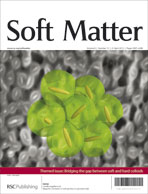Direct comparison of the rheology of model hard and soft particle glasses
Abstract
The effects of particle softness and the role of the outer shell mechanics on the linear viscoelasticity and yielding behaviour of colloidal glasses are critically assessed using three different model colloidal particles: (i) sterically stabilized PMMA particles with model hard sphere interactions, (ii) core–shell microgels with a deformable PNIPAM outer shell and (iii) ultra-soft star-like micelles with inter-penetrable multi-arms. The volume fraction dependence of the elastic modulus and the yield stress reflects the softness of the effective inter-particle potential. The yield strain exhibits distinct non-monotonic volume fraction dependence for hard spheres below close packing whereas for both soft particles it increases above close packing due to particle softness. Stress overshoots in start-up shear show a common increase with shear rate in all systems. However, the stress overshoots are significantly stronger in star-like micelles due to transient arm entanglements. In relation with that similar stress peaks are detected within the period of the large amplitude oscillatory shear only in star-like micelles. Finally, we discuss the scaling exponents for the G′ and G′′ decrease at large oscillatory strain amplitudes and their relation with steady shear stress.

- This article is part of the themed collection: Bridging the gap between soft and hard colloids

 Please wait while we load your content...
Please wait while we load your content...